University Health Research Report: Physical Activity and Migrants
VerifiedAdded on 2020/03/04
|11
|3000
|62
Report
AI Summary
This report presents a research proposal for a systematic review on the effects of physical activity on migrants, particularly culturally and linguistically diverse (CALD) women in Australia. The study aims to identify socio-cultural impacts, hindrances, and potential support systems for physical activity among this population, addressing health challenges such as cardiovascular problems, poor mental health, and diabetes. The report synthesizes findings from several studies, including focus groups, interviews, and systematic reviews, highlighting the influence of ethnic-specific themes like religious beliefs, socio-economic status, and language barriers. It emphasizes the need for tailored health promotion programs and increased opportunities for physical activity to address the unique challenges faced by migrants, ultimately improving their overall health outcomes. The research underscores the importance of understanding cultural factors and providing culturally sensitive healthcare services to promote physical activity participation and improve health outcomes for migrant populations in Australia.

Running head: APPLIED HEALTH RESEARCH
Applied health research
Name of the student:
Name of the university:
Author note:
Applied health research
Name of the student:
Name of the university:
Author note:
Paraphrase This Document
Need a fresh take? Get an instant paraphrase of this document with our AI Paraphraser

1APPLIED HEALTH RESEARCH
Introduction
This assignment is about a research proposal which contains a systemic review on the
topic “DOES PHYSICAL ACTIVITY EFFECTS ON MIGRANTS OF NEW COUNTRY”.
Australia witnesses the increasing levels of migration by people from culturally and
linguistically diverse (CALD) origins. With this developing population, Australia is facing
various health challenges (Sanou et al., 2014). Specifically, CALD ladies have an increased
rate of health risk, for example, cardiovascular problems, poor mental condition and diabetes.
Despite of the high risk of disease, ladies from CALD are less concerned about their health
care and to take preventive measures. The aim of this study is to look at the socio-cultural
impacts on the physical movement practices of CALD ladies living in Australia by
identifying the hindrances, barriers and people who can involve in the physical action support
for this population (Delavari et al., 2015).
Background
Australia witnesses a quick increase in movement of the refugees in the course of
recent years; with annual numbers those in double of the proportion of total population. With
the difference in the variety of this developing population Australia is facing various
healthcare challenges. Close examination of epidemiological information uncovers particular
problems of diseases in women from culturally and linguistically diverse (CALD) people
group now living all through Australia (Kennedy et al., 2015). In addition, there is an
agreement among western nations, including Australia, New Zealand, United Kingdom,
United States and Canada, that the cultural and ethnic disparities exist as to occurrence, of
mortality, and higher rates of risks for various infections in the persons. Out of these the
specific concern is the risk of hypertension, diabetes, and overweight, all of which are
transcendent risk factors to cardiovascular disease (CVD) (Rosso & McGrath, 2016).
Introduction
This assignment is about a research proposal which contains a systemic review on the
topic “DOES PHYSICAL ACTIVITY EFFECTS ON MIGRANTS OF NEW COUNTRY”.
Australia witnesses the increasing levels of migration by people from culturally and
linguistically diverse (CALD) origins. With this developing population, Australia is facing
various health challenges (Sanou et al., 2014). Specifically, CALD ladies have an increased
rate of health risk, for example, cardiovascular problems, poor mental condition and diabetes.
Despite of the high risk of disease, ladies from CALD are less concerned about their health
care and to take preventive measures. The aim of this study is to look at the socio-cultural
impacts on the physical movement practices of CALD ladies living in Australia by
identifying the hindrances, barriers and people who can involve in the physical action support
for this population (Delavari et al., 2015).
Background
Australia witnesses a quick increase in movement of the refugees in the course of
recent years; with annual numbers those in double of the proportion of total population. With
the difference in the variety of this developing population Australia is facing various
healthcare challenges. Close examination of epidemiological information uncovers particular
problems of diseases in women from culturally and linguistically diverse (CALD) people
group now living all through Australia (Kennedy et al., 2015). In addition, there is an
agreement among western nations, including Australia, New Zealand, United Kingdom,
United States and Canada, that the cultural and ethnic disparities exist as to occurrence, of
mortality, and higher rates of risks for various infections in the persons. Out of these the
specific concern is the risk of hypertension, diabetes, and overweight, all of which are
transcendent risk factors to cardiovascular disease (CVD) (Rosso & McGrath, 2016).

2APPLIED HEALTH RESEARCH
Method
In the first article (Caperchione, et al. 2011), twelve sessions were done with the
focused group of CALD women (N = 110) from Bosnia, Arabia, Filipinos and Sudan who
settled in three regions, i.e., New South Wales, Victoria, and Queensland. The participants
asked to tell their views and beliefs for the socio-cultural influences on their physical activity
behaviors.
In the second article (Guerin et al., 2003) , the study has been done in Hamilton, New
Zealand, among the population of 108,000 people of varying ethnic and cultural
backgrounds.
In the third article (Caperchione et al., 2013), interviews that are semi structured were
done with 15 different health care providers across the three populous states in Australia, i.e.,
New South Wales, Queensland, Victoria, and the content was analysis was used to examine
the data.
In the fourth article (O’Driscoll 2014), the review was systematically identified 72
papers, which includes 6 interventions, 18 qualitative and 48 quantitative studies. The
correlates that were identified highlights the complexities that were needed to work with
migrants. The correlates were divided into four groups, which are socialization, statistic,
psychosocial and environmental/organizational. The social and ecological model identifies
the correlates such as social support and safety. However, there were some correlates which
are unique relating to individuals those who are facing cultural issues such as socialization
and language.
Search strategy
The first step was searching for studies or reports which contain the details of the
population in Pub Med, CINAHL, MEDLINE, WHO - World Health Organization, Google
Method
In the first article (Caperchione, et al. 2011), twelve sessions were done with the
focused group of CALD women (N = 110) from Bosnia, Arabia, Filipinos and Sudan who
settled in three regions, i.e., New South Wales, Victoria, and Queensland. The participants
asked to tell their views and beliefs for the socio-cultural influences on their physical activity
behaviors.
In the second article (Guerin et al., 2003) , the study has been done in Hamilton, New
Zealand, among the population of 108,000 people of varying ethnic and cultural
backgrounds.
In the third article (Caperchione et al., 2013), interviews that are semi structured were
done with 15 different health care providers across the three populous states in Australia, i.e.,
New South Wales, Queensland, Victoria, and the content was analysis was used to examine
the data.
In the fourth article (O’Driscoll 2014), the review was systematically identified 72
papers, which includes 6 interventions, 18 qualitative and 48 quantitative studies. The
correlates that were identified highlights the complexities that were needed to work with
migrants. The correlates were divided into four groups, which are socialization, statistic,
psychosocial and environmental/organizational. The social and ecological model identifies
the correlates such as social support and safety. However, there were some correlates which
are unique relating to individuals those who are facing cultural issues such as socialization
and language.
Search strategy
The first step was searching for studies or reports which contain the details of the
population in Pub Med, CINAHL, MEDLINE, WHO - World Health Organization, Google
⊘ This is a preview!⊘
Do you want full access?
Subscribe today to unlock all pages.

Trusted by 1+ million students worldwide
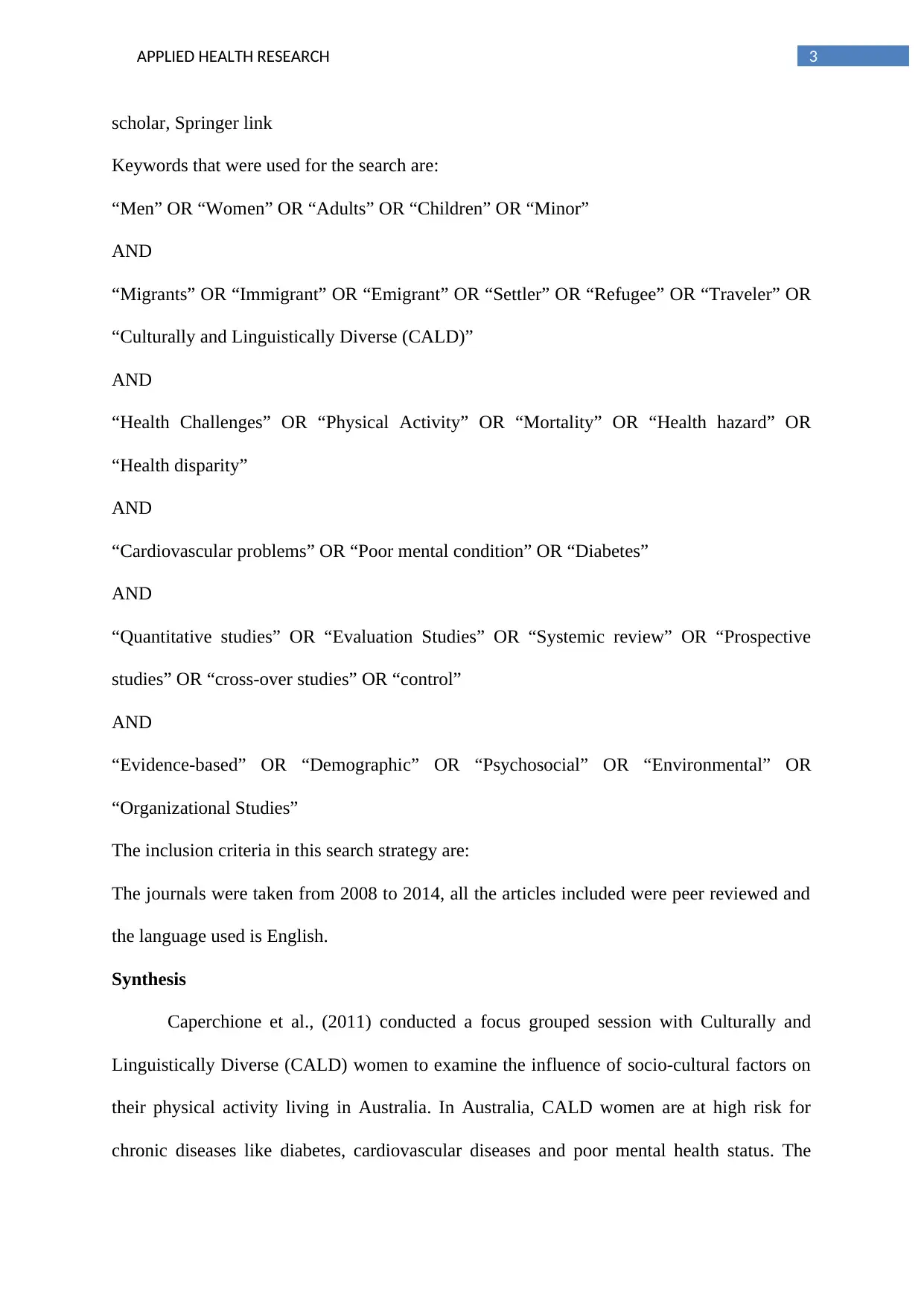
3APPLIED HEALTH RESEARCH
scholar, Springer link
Keywords that were used for the search are:
“Men” OR “Women” OR “Adults” OR “Children” OR “Minor”
AND
“Migrants” OR “Immigrant” OR “Emigrant” OR “Settler” OR “Refugee” OR “Traveler” OR
“Culturally and Linguistically Diverse (CALD)”
AND
“Health Challenges” OR “Physical Activity” OR “Mortality” OR “Health hazard” OR
“Health disparity”
AND
“Cardiovascular problems” OR “Poor mental condition” OR “Diabetes”
AND
“Quantitative studies” OR “Evaluation Studies” OR “Systemic review” OR “Prospective
studies” OR “cross-over studies” OR “control”
AND
“Evidence-based” OR “Demographic” OR “Psychosocial” OR “Environmental” OR
“Organizational Studies”
The inclusion criteria in this search strategy are:
The journals were taken from 2008 to 2014, all the articles included were peer reviewed and
the language used is English.
Synthesis
Caperchione et al., (2011) conducted a focus grouped session with Culturally and
Linguistically Diverse (CALD) women to examine the influence of socio-cultural factors on
their physical activity living in Australia. In Australia, CALD women are at high risk for
chronic diseases like diabetes, cardiovascular diseases and poor mental health status. The
scholar, Springer link
Keywords that were used for the search are:
“Men” OR “Women” OR “Adults” OR “Children” OR “Minor”
AND
“Migrants” OR “Immigrant” OR “Emigrant” OR “Settler” OR “Refugee” OR “Traveler” OR
“Culturally and Linguistically Diverse (CALD)”
AND
“Health Challenges” OR “Physical Activity” OR “Mortality” OR “Health hazard” OR
“Health disparity”
AND
“Cardiovascular problems” OR “Poor mental condition” OR “Diabetes”
AND
“Quantitative studies” OR “Evaluation Studies” OR “Systemic review” OR “Prospective
studies” OR “cross-over studies” OR “control”
AND
“Evidence-based” OR “Demographic” OR “Psychosocial” OR “Environmental” OR
“Organizational Studies”
The inclusion criteria in this search strategy are:
The journals were taken from 2008 to 2014, all the articles included were peer reviewed and
the language used is English.
Synthesis
Caperchione et al., (2011) conducted a focus grouped session with Culturally and
Linguistically Diverse (CALD) women to examine the influence of socio-cultural factors on
their physical activity living in Australia. In Australia, CALD women are at high risk for
chronic diseases like diabetes, cardiovascular diseases and poor mental health status. The
Paraphrase This Document
Need a fresh take? Get an instant paraphrase of this document with our AI Paraphraser
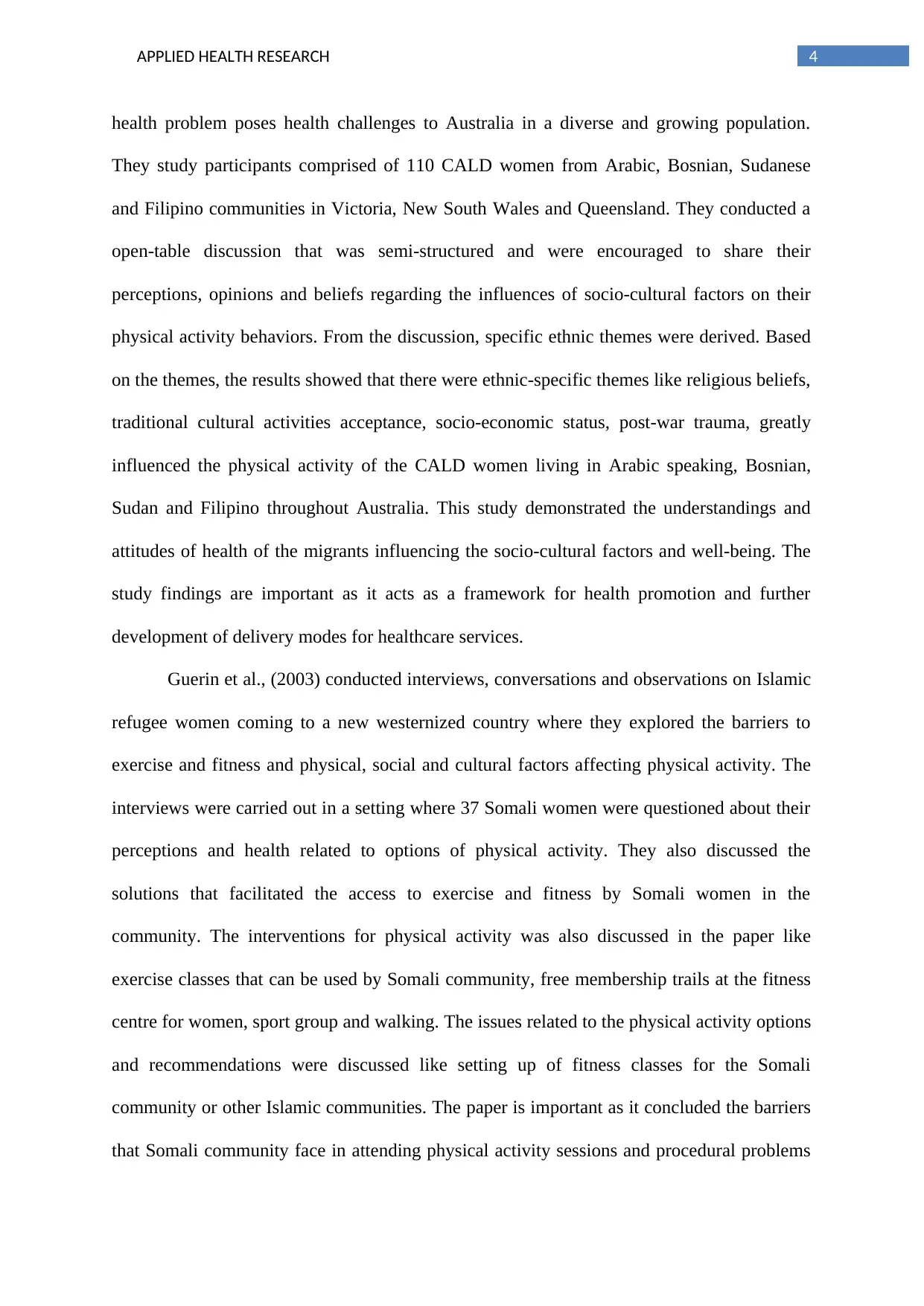
4APPLIED HEALTH RESEARCH
health problem poses health challenges to Australia in a diverse and growing population.
They study participants comprised of 110 CALD women from Arabic, Bosnian, Sudanese
and Filipino communities in Victoria, New South Wales and Queensland. They conducted a
open-table discussion that was semi-structured and were encouraged to share their
perceptions, opinions and beliefs regarding the influences of socio-cultural factors on their
physical activity behaviors. From the discussion, specific ethnic themes were derived. Based
on the themes, the results showed that there were ethnic-specific themes like religious beliefs,
traditional cultural activities acceptance, socio-economic status, post-war trauma, greatly
influenced the physical activity of the CALD women living in Arabic speaking, Bosnian,
Sudan and Filipino throughout Australia. This study demonstrated the understandings and
attitudes of health of the migrants influencing the socio-cultural factors and well-being. The
study findings are important as it acts as a framework for health promotion and further
development of delivery modes for healthcare services.
Guerin et al., (2003) conducted interviews, conversations and observations on Islamic
refugee women coming to a new westernized country where they explored the barriers to
exercise and fitness and physical, social and cultural factors affecting physical activity. The
interviews were carried out in a setting where 37 Somali women were questioned about their
perceptions and health related to options of physical activity. They also discussed the
solutions that facilitated the access to exercise and fitness by Somali women in the
community. The interventions for physical activity was also discussed in the paper like
exercise classes that can be used by Somali community, free membership trails at the fitness
centre for women, sport group and walking. The issues related to the physical activity options
and recommendations were discussed like setting up of fitness classes for the Somali
community or other Islamic communities. The paper is important as it concluded the barriers
that Somali community face in attending physical activity sessions and procedural problems
health problem poses health challenges to Australia in a diverse and growing population.
They study participants comprised of 110 CALD women from Arabic, Bosnian, Sudanese
and Filipino communities in Victoria, New South Wales and Queensland. They conducted a
open-table discussion that was semi-structured and were encouraged to share their
perceptions, opinions and beliefs regarding the influences of socio-cultural factors on their
physical activity behaviors. From the discussion, specific ethnic themes were derived. Based
on the themes, the results showed that there were ethnic-specific themes like religious beliefs,
traditional cultural activities acceptance, socio-economic status, post-war trauma, greatly
influenced the physical activity of the CALD women living in Arabic speaking, Bosnian,
Sudan and Filipino throughout Australia. This study demonstrated the understandings and
attitudes of health of the migrants influencing the socio-cultural factors and well-being. The
study findings are important as it acts as a framework for health promotion and further
development of delivery modes for healthcare services.
Guerin et al., (2003) conducted interviews, conversations and observations on Islamic
refugee women coming to a new westernized country where they explored the barriers to
exercise and fitness and physical, social and cultural factors affecting physical activity. The
interviews were carried out in a setting where 37 Somali women were questioned about their
perceptions and health related to options of physical activity. They also discussed the
solutions that facilitated the access to exercise and fitness by Somali women in the
community. The interventions for physical activity was also discussed in the paper like
exercise classes that can be used by Somali community, free membership trails at the fitness
centre for women, sport group and walking. The issues related to the physical activity options
and recommendations were discussed like setting up of fitness classes for the Somali
community or other Islamic communities. The paper is important as it concluded the barriers
that Somali community face in attending physical activity sessions and procedural problems
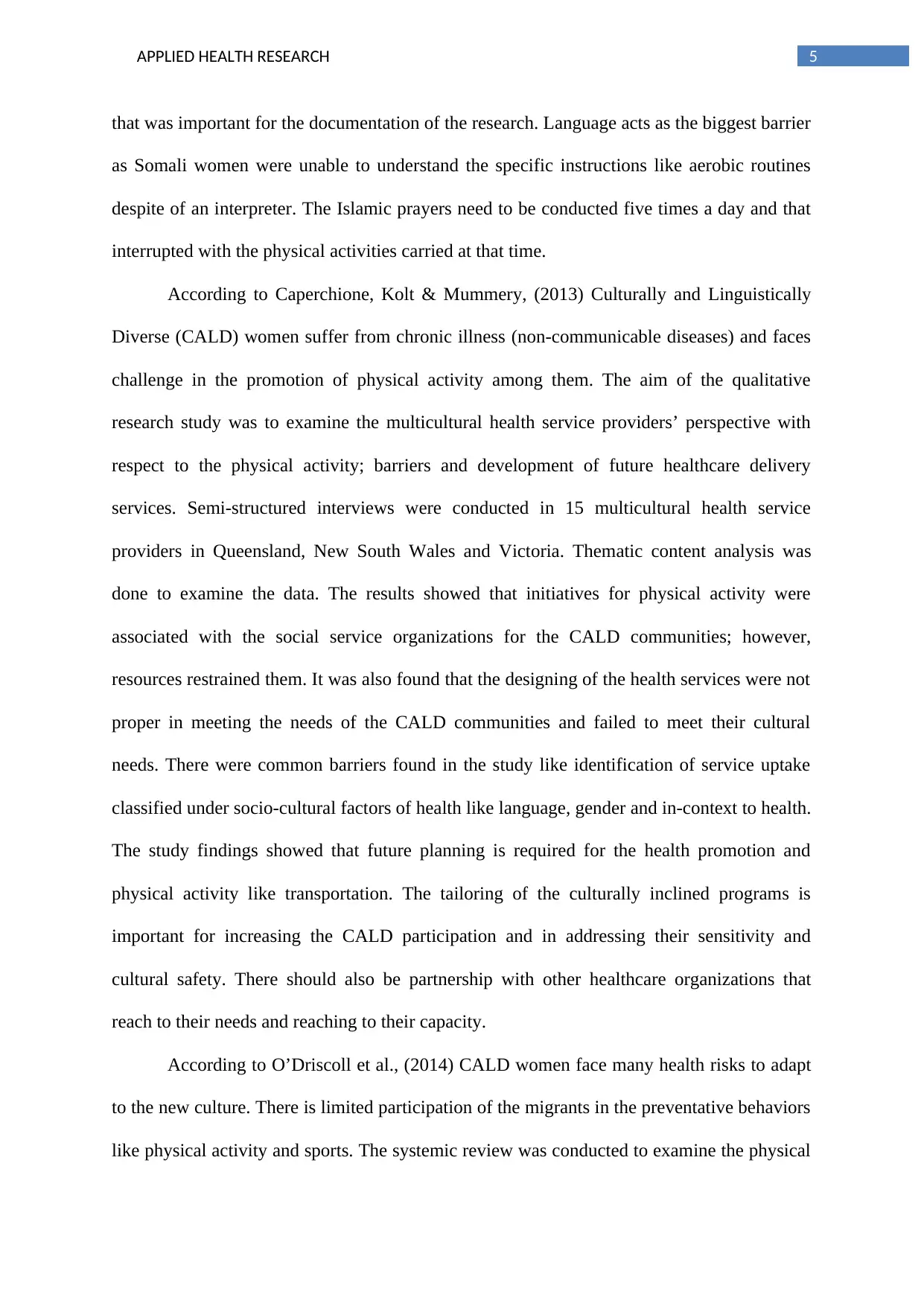
5APPLIED HEALTH RESEARCH
that was important for the documentation of the research. Language acts as the biggest barrier
as Somali women were unable to understand the specific instructions like aerobic routines
despite of an interpreter. The Islamic prayers need to be conducted five times a day and that
interrupted with the physical activities carried at that time.
According to Caperchione, Kolt & Mummery, (2013) Culturally and Linguistically
Diverse (CALD) women suffer from chronic illness (non-communicable diseases) and faces
challenge in the promotion of physical activity among them. The aim of the qualitative
research study was to examine the multicultural health service providers’ perspective with
respect to the physical activity; barriers and development of future healthcare delivery
services. Semi-structured interviews were conducted in 15 multicultural health service
providers in Queensland, New South Wales and Victoria. Thematic content analysis was
done to examine the data. The results showed that initiatives for physical activity were
associated with the social service organizations for the CALD communities; however,
resources restrained them. It was also found that the designing of the health services were not
proper in meeting the needs of the CALD communities and failed to meet their cultural
needs. There were common barriers found in the study like identification of service uptake
classified under socio-cultural factors of health like language, gender and in-context to health.
The study findings showed that future planning is required for the health promotion and
physical activity like transportation. The tailoring of the culturally inclined programs is
important for increasing the CALD participation and in addressing their sensitivity and
cultural safety. There should also be partnership with other healthcare organizations that
reach to their needs and reaching to their capacity.
According to O’Driscoll et al., (2014) CALD women face many health risks to adapt
to the new culture. There is limited participation of the migrants in the preventative behaviors
like physical activity and sports. The systemic review was conducted to examine the physical
that was important for the documentation of the research. Language acts as the biggest barrier
as Somali women were unable to understand the specific instructions like aerobic routines
despite of an interpreter. The Islamic prayers need to be conducted five times a day and that
interrupted with the physical activities carried at that time.
According to Caperchione, Kolt & Mummery, (2013) Culturally and Linguistically
Diverse (CALD) women suffer from chronic illness (non-communicable diseases) and faces
challenge in the promotion of physical activity among them. The aim of the qualitative
research study was to examine the multicultural health service providers’ perspective with
respect to the physical activity; barriers and development of future healthcare delivery
services. Semi-structured interviews were conducted in 15 multicultural health service
providers in Queensland, New South Wales and Victoria. Thematic content analysis was
done to examine the data. The results showed that initiatives for physical activity were
associated with the social service organizations for the CALD communities; however,
resources restrained them. It was also found that the designing of the health services were not
proper in meeting the needs of the CALD communities and failed to meet their cultural
needs. There were common barriers found in the study like identification of service uptake
classified under socio-cultural factors of health like language, gender and in-context to health.
The study findings showed that future planning is required for the health promotion and
physical activity like transportation. The tailoring of the culturally inclined programs is
important for increasing the CALD participation and in addressing their sensitivity and
cultural safety. There should also be partnership with other healthcare organizations that
reach to their needs and reaching to their capacity.
According to O’Driscoll et al., (2014) CALD women face many health risks to adapt
to the new culture. There is limited participation of the migrants in the preventative behaviors
like physical activity and sports. The systemic review was conducted to examine the physical
⊘ This is a preview!⊘
Do you want full access?
Subscribe today to unlock all pages.

Trusted by 1+ million students worldwide

6APPLIED HEALTH RESEARCH
activity and sports participation among the migrants. The systemic review was conducted
using 72 papers, 48 quantitative studies, 18 qualitative and 6 interventions. The 44 studies
that were identified correlated the highlighting of the complexities that was witnessed while
working with the migrant population. Thematic analysis was done divided into four themes
like psychosocial, acculturation, demographic and social ecological model. This model was
important and helped to correlate the themes like safety and social support. However, the
study had limitations where the migrants face cultural challenges like language and
acculturation. Concisely, there is lack of contextualization among the CALD migrants in
regard to their experiences in physical activity and sports and provide scope for future
research for comprehensive cultural comprehension.
The findings from the above paper showed that CALD women face barriers and
challenges in accessing the healthcare services and physical activity participation. There are
socio-cultural influences that affect the behavior of the CALD women in Australia (Delavari
et al., 2013). There are various constraints and barriers that migrants face while participating
in physical activity and sport. Language acts as the main barrier that makes it difficult for
them to understand the specific instructions during the physical activity (Renzaho et al.,
2011). Cultural factors like praying of the Muslim community also act as barrier as it
interfere with the physical activity participation and sports. There is a need to address the
cultural and social needs of the migrants that increase their adherence to physical activity
participation and sports (Cleland et al., 2012). There is also lack of health promotion
programs among the migrants and making them understand the mental and physical benefits
of physical exercise. Overall, it can be stated that there is need to increase the opportunities
for physical activity participation by the migrants and health promotion programs.
Communication also need to be enhanced with the migrant population that helps to identify
their opportunities and programs to address their physical needs and enhance their
activity and sports participation among the migrants. The systemic review was conducted
using 72 papers, 48 quantitative studies, 18 qualitative and 6 interventions. The 44 studies
that were identified correlated the highlighting of the complexities that was witnessed while
working with the migrant population. Thematic analysis was done divided into four themes
like psychosocial, acculturation, demographic and social ecological model. This model was
important and helped to correlate the themes like safety and social support. However, the
study had limitations where the migrants face cultural challenges like language and
acculturation. Concisely, there is lack of contextualization among the CALD migrants in
regard to their experiences in physical activity and sports and provide scope for future
research for comprehensive cultural comprehension.
The findings from the above paper showed that CALD women face barriers and
challenges in accessing the healthcare services and physical activity participation. There are
socio-cultural influences that affect the behavior of the CALD women in Australia (Delavari
et al., 2013). There are various constraints and barriers that migrants face while participating
in physical activity and sport. Language acts as the main barrier that makes it difficult for
them to understand the specific instructions during the physical activity (Renzaho et al.,
2011). Cultural factors like praying of the Muslim community also act as barrier as it
interfere with the physical activity participation and sports. There is a need to address the
cultural and social needs of the migrants that increase their adherence to physical activity
participation and sports (Cleland et al., 2012). There is also lack of health promotion
programs among the migrants and making them understand the mental and physical benefits
of physical exercise. Overall, it can be stated that there is need to increase the opportunities
for physical activity participation by the migrants and health promotion programs.
Communication also need to be enhanced with the migrant population that helps to identify
their opportunities and programs to address their physical needs and enhance their
Paraphrase This Document
Need a fresh take? Get an instant paraphrase of this document with our AI Paraphraser
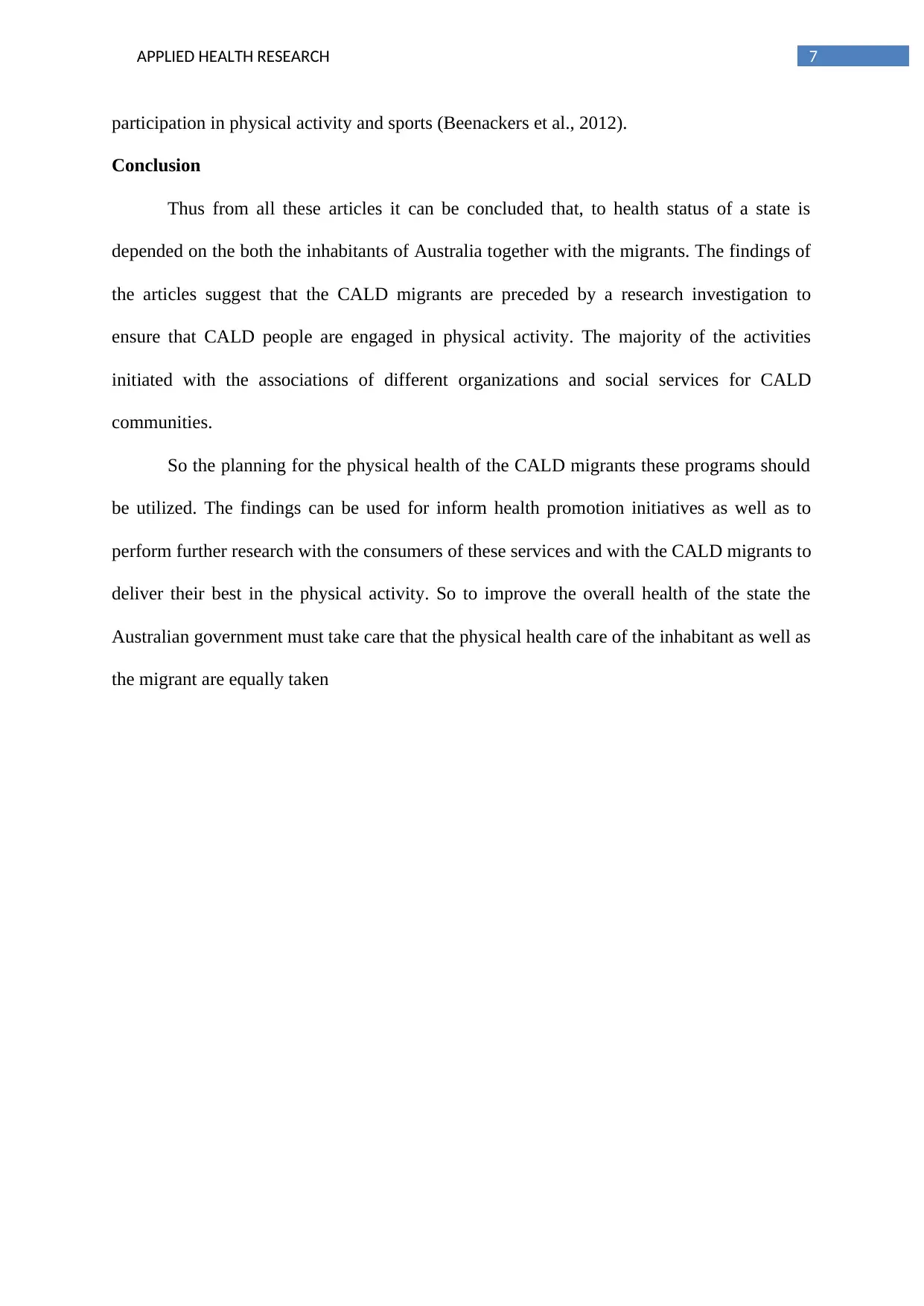
7APPLIED HEALTH RESEARCH
participation in physical activity and sports (Beenackers et al., 2012).
Conclusion
Thus from all these articles it can be concluded that, to health status of a state is
depended on the both the inhabitants of Australia together with the migrants. The findings of
the articles suggest that the CALD migrants are preceded by a research investigation to
ensure that CALD people are engaged in physical activity. The majority of the activities
initiated with the associations of different organizations and social services for CALD
communities.
So the planning for the physical health of the CALD migrants these programs should
be utilized. The findings can be used for inform health promotion initiatives as well as to
perform further research with the consumers of these services and with the CALD migrants to
deliver their best in the physical activity. So to improve the overall health of the state the
Australian government must take care that the physical health care of the inhabitant as well as
the migrant are equally taken
participation in physical activity and sports (Beenackers et al., 2012).
Conclusion
Thus from all these articles it can be concluded that, to health status of a state is
depended on the both the inhabitants of Australia together with the migrants. The findings of
the articles suggest that the CALD migrants are preceded by a research investigation to
ensure that CALD people are engaged in physical activity. The majority of the activities
initiated with the associations of different organizations and social services for CALD
communities.
So the planning for the physical health of the CALD migrants these programs should
be utilized. The findings can be used for inform health promotion initiatives as well as to
perform further research with the consumers of these services and with the CALD migrants to
deliver their best in the physical activity. So to improve the overall health of the state the
Australian government must take care that the physical health care of the inhabitant as well as
the migrant are equally taken
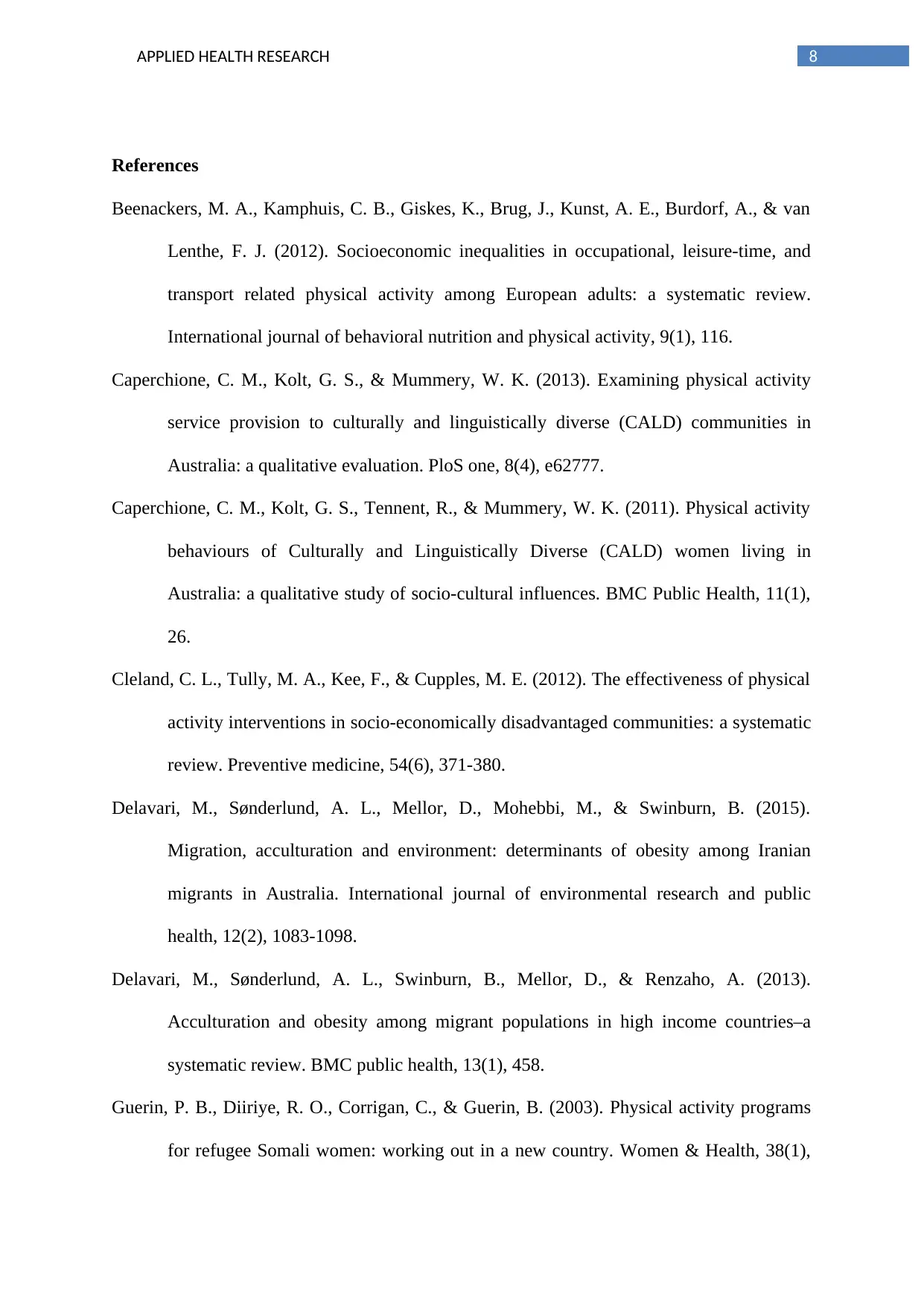
8APPLIED HEALTH RESEARCH
References
Beenackers, M. A., Kamphuis, C. B., Giskes, K., Brug, J., Kunst, A. E., Burdorf, A., & van
Lenthe, F. J. (2012). Socioeconomic inequalities in occupational, leisure-time, and
transport related physical activity among European adults: a systematic review.
International journal of behavioral nutrition and physical activity, 9(1), 116.
Caperchione, C. M., Kolt, G. S., & Mummery, W. K. (2013). Examining physical activity
service provision to culturally and linguistically diverse (CALD) communities in
Australia: a qualitative evaluation. PloS one, 8(4), e62777.
Caperchione, C. M., Kolt, G. S., Tennent, R., & Mummery, W. K. (2011). Physical activity
behaviours of Culturally and Linguistically Diverse (CALD) women living in
Australia: a qualitative study of socio-cultural influences. BMC Public Health, 11(1),
26.
Cleland, C. L., Tully, M. A., Kee, F., & Cupples, M. E. (2012). The effectiveness of physical
activity interventions in socio-economically disadvantaged communities: a systematic
review. Preventive medicine, 54(6), 371-380.
Delavari, M., Sønderlund, A. L., Mellor, D., Mohebbi, M., & Swinburn, B. (2015).
Migration, acculturation and environment: determinants of obesity among Iranian
migrants in Australia. International journal of environmental research and public
health, 12(2), 1083-1098.
Delavari, M., Sønderlund, A. L., Swinburn, B., Mellor, D., & Renzaho, A. (2013).
Acculturation and obesity among migrant populations in high income countries–a
systematic review. BMC public health, 13(1), 458.
Guerin, P. B., Diiriye, R. O., Corrigan, C., & Guerin, B. (2003). Physical activity programs
for refugee Somali women: working out in a new country. Women & Health, 38(1),
References
Beenackers, M. A., Kamphuis, C. B., Giskes, K., Brug, J., Kunst, A. E., Burdorf, A., & van
Lenthe, F. J. (2012). Socioeconomic inequalities in occupational, leisure-time, and
transport related physical activity among European adults: a systematic review.
International journal of behavioral nutrition and physical activity, 9(1), 116.
Caperchione, C. M., Kolt, G. S., & Mummery, W. K. (2013). Examining physical activity
service provision to culturally and linguistically diverse (CALD) communities in
Australia: a qualitative evaluation. PloS one, 8(4), e62777.
Caperchione, C. M., Kolt, G. S., Tennent, R., & Mummery, W. K. (2011). Physical activity
behaviours of Culturally and Linguistically Diverse (CALD) women living in
Australia: a qualitative study of socio-cultural influences. BMC Public Health, 11(1),
26.
Cleland, C. L., Tully, M. A., Kee, F., & Cupples, M. E. (2012). The effectiveness of physical
activity interventions in socio-economically disadvantaged communities: a systematic
review. Preventive medicine, 54(6), 371-380.
Delavari, M., Sønderlund, A. L., Mellor, D., Mohebbi, M., & Swinburn, B. (2015).
Migration, acculturation and environment: determinants of obesity among Iranian
migrants in Australia. International journal of environmental research and public
health, 12(2), 1083-1098.
Delavari, M., Sønderlund, A. L., Swinburn, B., Mellor, D., & Renzaho, A. (2013).
Acculturation and obesity among migrant populations in high income countries–a
systematic review. BMC public health, 13(1), 458.
Guerin, P. B., Diiriye, R. O., Corrigan, C., & Guerin, B. (2003). Physical activity programs
for refugee Somali women: working out in a new country. Women & Health, 38(1),
⊘ This is a preview!⊘
Do you want full access?
Subscribe today to unlock all pages.

Trusted by 1+ million students worldwide

9APPLIED HEALTH RESEARCH
83-99.
Kennedy, S., Kidd, M. P., McDonald, J. T., & Biddle, N. (2015). The healthy immigrant
effect: patterns and evidence from four countries. Journal of International Migration
and Integration, 16(2), 317-332.
O’Driscoll, T., Banting, L. K., Borkoles, E., Eime, R., & Polman, R. (2014). A systematic
literature review of sport and physical activity participation in culturally and
linguistically diverse (CALD) migrant populations. Journal of immigrant and minority
health, 16(3), 515-530.
Renzaho, A., Green, J., Mellor, D., & Swinburn, B. (2011). Parenting, family functioning and
lifestyle in a new culture: the case of African migrants in Melbourne, Victoria,
Australia. Child & family social work, 16(2), 228-240.
Rosso, E., & McGrath, R. (2016). Promoting physical activity among children and youth in
disadvantaged South Australian CALD communities through alternative community
sport opportunities. Health Promotion Journal of Australia, 27(2), 105-110.
Sanou, D., O’Reilly, E., Ngnie-Teta, I., Batal, M., Mondain, N., Andrew, C., ... &
Bourgeault, I. L. (2014). Acculturation and nutritional health of immigrants in
Canada: a scoping review. Journal of Immigrant and Minority Health, 16(1), 24-34.
83-99.
Kennedy, S., Kidd, M. P., McDonald, J. T., & Biddle, N. (2015). The healthy immigrant
effect: patterns and evidence from four countries. Journal of International Migration
and Integration, 16(2), 317-332.
O’Driscoll, T., Banting, L. K., Borkoles, E., Eime, R., & Polman, R. (2014). A systematic
literature review of sport and physical activity participation in culturally and
linguistically diverse (CALD) migrant populations. Journal of immigrant and minority
health, 16(3), 515-530.
Renzaho, A., Green, J., Mellor, D., & Swinburn, B. (2011). Parenting, family functioning and
lifestyle in a new culture: the case of African migrants in Melbourne, Victoria,
Australia. Child & family social work, 16(2), 228-240.
Rosso, E., & McGrath, R. (2016). Promoting physical activity among children and youth in
disadvantaged South Australian CALD communities through alternative community
sport opportunities. Health Promotion Journal of Australia, 27(2), 105-110.
Sanou, D., O’Reilly, E., Ngnie-Teta, I., Batal, M., Mondain, N., Andrew, C., ... &
Bourgeault, I. L. (2014). Acculturation and nutritional health of immigrants in
Canada: a scoping review. Journal of Immigrant and Minority Health, 16(1), 24-34.
Paraphrase This Document
Need a fresh take? Get an instant paraphrase of this document with our AI Paraphraser
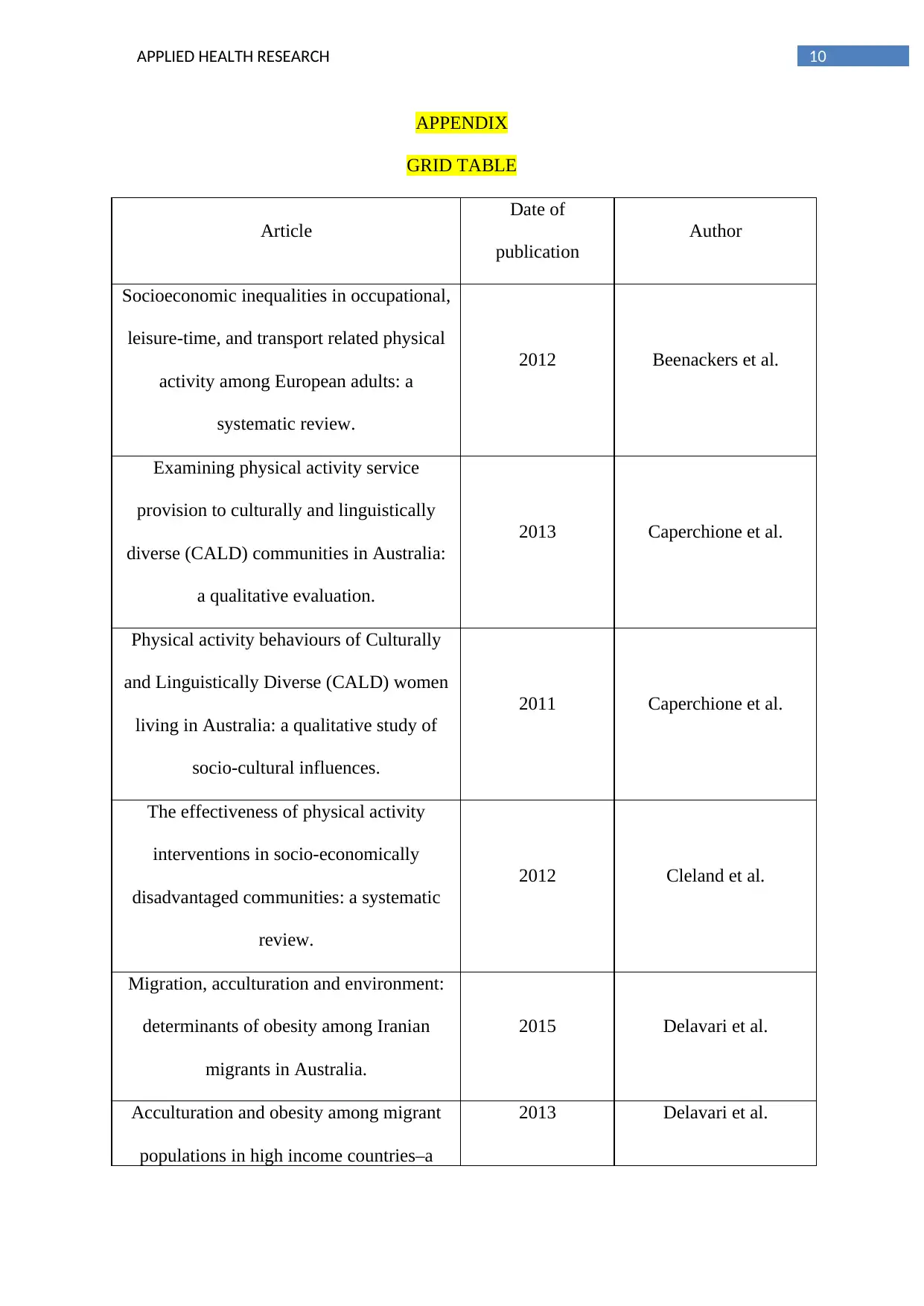
10APPLIED HEALTH RESEARCH
APPENDIX
GRID TABLE
Article
Date of
publication
Author
Socioeconomic inequalities in occupational,
leisure-time, and transport related physical
activity among European adults: a
systematic review.
2012 Beenackers et al.
Examining physical activity service
provision to culturally and linguistically
diverse (CALD) communities in Australia:
a qualitative evaluation.
2013 Caperchione et al.
Physical activity behaviours of Culturally
and Linguistically Diverse (CALD) women
living in Australia: a qualitative study of
socio-cultural influences.
2011 Caperchione et al.
The effectiveness of physical activity
interventions in socio-economically
disadvantaged communities: a systematic
review.
2012 Cleland et al.
Migration, acculturation and environment:
determinants of obesity among Iranian
migrants in Australia.
2015 Delavari et al.
Acculturation and obesity among migrant
populations in high income countries–a
2013 Delavari et al.
APPENDIX
GRID TABLE
Article
Date of
publication
Author
Socioeconomic inequalities in occupational,
leisure-time, and transport related physical
activity among European adults: a
systematic review.
2012 Beenackers et al.
Examining physical activity service
provision to culturally and linguistically
diverse (CALD) communities in Australia:
a qualitative evaluation.
2013 Caperchione et al.
Physical activity behaviours of Culturally
and Linguistically Diverse (CALD) women
living in Australia: a qualitative study of
socio-cultural influences.
2011 Caperchione et al.
The effectiveness of physical activity
interventions in socio-economically
disadvantaged communities: a systematic
review.
2012 Cleland et al.
Migration, acculturation and environment:
determinants of obesity among Iranian
migrants in Australia.
2015 Delavari et al.
Acculturation and obesity among migrant
populations in high income countries–a
2013 Delavari et al.
1 out of 11
Related Documents
Your All-in-One AI-Powered Toolkit for Academic Success.
+13062052269
info@desklib.com
Available 24*7 on WhatsApp / Email
![[object Object]](/_next/static/media/star-bottom.7253800d.svg)
Unlock your academic potential
Copyright © 2020–2025 A2Z Services. All Rights Reserved. Developed and managed by ZUCOL.





